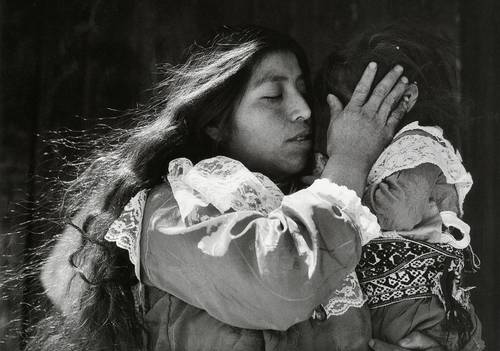Images like The exterminating angel (1991), Caress (1989), M (1981), Cover Huipil (1962), The salt became brunette (1989) y Mazahuas women (1989) are perhaps familiar to the eyes of the public, although he does not know the name of its author.
The author of these pieces, the Mexican photographer of US origin Mariana Yammpolsky, who knew how to put His deep knowledge of the technique at the service of their interest in indigenous, peasant and popular traditions
was born on September 6, 1925 in Chicago and died on May 3, 2002 in Mexico City. His work was declared Documentary Heritage of Mexico by the United Nations Organization for Education, Science and Culture in 2021.
At the end of her studies at the University of Chicago, in 1945 the young woman traveled to Mexico because He listened to a talk from a couple of recorders about the social work to which the members of the Popular Graphic Workshop (TGP) had committed; at that moment he decided that he wanted
published in 1999, the writer Elena Poniatowska. After a few months of coexistence with the members of the TGP, He knew that Mexico was going to be his country, and the teammates, his family
. Over time he dedicated himself to photography.
To commemorate Mariana Yampolsky’s native centenary, the Ibero -American University (UIA), an institution that protects and preserves since 2018 the artist’s photographic background and the personal library of the artist, in addition to the archive of the foundation that bore her name, began a program of activities Since last October, which includes exhibitions and publications. Together there are 76 thousand negatives that custody the Xavier Clavier library (BFXC), of the UIA.
María de Mária Campos, academic of the BFXC, points out that the enclosure also protects the Yamampolsky popular art collection, from about 5,000 objects – in cataloging process -, its personal, documentary and photographic file, with images of your friends , his family and his childhood.
Besides, We have a collection of 2,500 drawings made by Mariana and another of engravings and their plates, which he made when he was in the TGP
. The collection is in a specialized vault with moisture and temperature control.
The exhibition The last abode It was held last October 29 in collaboration with the Ibero Prepa. The sample The house that sings, With images of this project, it will be held at the UIA facilities, between March and April, together with the presentation of the book of the same name. The publication was redited in 2024 by Infonavit, the Ministry of Public Education and the UIA.
The team is also scheduled for September All Mariana, with material of the documentary and photographic personal archive, in collaboration with the Department of Art and the BFXC.
Extramuros, an exhibition is prepared together with the infonavit about The house that sings To appear at the Housing Museum, whose dates are about to be defined. An exhibition of images captured by Yampolsky of older adults is also contemplated, to be held at the Ortega-Marañón University Institute in Madrid.
Editorial relaunches
In the area of publications the reprint of Poblana haciendas, Book published for the first time in 1992 by the Department of History of the UIA and the V Centenary Commission of the State, with images of Yammpolsky, texts by Ricardo Rendón, and advice and research by Óscar Hagerman. Also, a book of the artist’s personal archive with unpublished photographs and documents.
At the same time, the BFXC works to have 5 thousand images of the photographer available in its digital catalog for online consultation. In addition to this, we work on the classification of the 76 thousand negatives that the photographic archive has for the scope of the public in the UIA digital heritage.
On the eve of the milestone, the center of the image (ci) published in 2024 Mariana Yamposky: the gesture of photographing, on the occasion of the incorporation of a part of the photographer’s file to her collection. Coordinated and edited by the specialist Deborah Dorotinsky, this digital book seeks to contribute to a greater knowledge of the black and white images already color that make up its file, while proposing new readings to already disseminated works and showing other unpublished.
The edition is the result of an approach to the Yammpolsky Photograph Memory image, carried out there in 1998. It includes texts of researchers from different generations and looks, such as David Fajardo Tapia, Eugenia Macías, Ana Elena Mallet, Rebeca Monroy Nasr, Abigail Pasillas Mendoza, Valeria Sánchez Michel and Sol Rubin de la Borbolla.
The book offers a selection of Yammpolsky’s interest issues at different times of its trajectory: cemeteries and their sculptural figures; Ritual activities in indigenous and peasant communities in Mexico, as well as indigenous rural life. Also, scenes of his visit to Egypt, when he started, and the photograph of vernacular architecture through a set of color images.
In addition, work is also addressed as a series of 157 photographs dedicated to the fashion designer Beatriz Russek. The book is downloaded for free from the website of CI: ci.cultura.gob.mx/publicaciones, in its unpublished section. It is expected soon to have a printed edition.
The IC will continue with its efforts to publicize Yammpolsky’s work in other venues, with the itinerance of a part of the exhibition Between foreign bodies, mounted in 2022. The spaces are about to be confirmed. Similarly, dialogue tables will be organized around your work.
